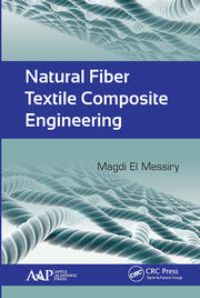Natural Fiber Textile Composite Engineering
Material type: TextLanguage: English Publication details: Oakville, ON : Apple Academic Press, c2017Description: xx, 360 p. : illISBN:
TextLanguage: English Publication details: Oakville, ON : Apple Academic Press, c2017Description: xx, 360 p. : illISBN: - 9781774636602
- 620.197 ELM
| Item type | Current library | Collection | Shelving location | Call number | Copy number | Status | Date due | Barcode |
|---|---|---|---|---|---|---|---|---|
 Reference Collection
Reference Collection
|
Reference Section | Department of Textile Engineering | Reference Section | 620.197 ELM | 2023-24 | Available | 98606 |
Biography
Magdi El Messiry, PhD, is currently Professor of Textile Composite Material Engineering in the Faculty of Engineering at Alexandria University, Egypt. He held the position of Vice Dean for Community Services and Environmental Affairs at Alexandria University from 1994 to 1998 and was the Head of the Textile Department (2000–2002 and 2005-2011). For his experience in the textile field, he was appointed as a member of the Directing Board of Spinning and Weaving Holding Company, the main Textile Company in Egypt, and is also a technical adviser to the Owner Board.
His list of publications exceeds 150 papers in the different fields of textile and materials science. He has participated in the establishment of a several textile departments in Egypt and in Arab countries and has carried out several granted projects at the international level with the colleagues from UK, France, Spain, USA, Czech Republic, Algeria, Tunisia, and Morocco. He also participates in scientific boards of several journals. In the last five years he has acted as an international expert in innovation and technology transfer. In 1999, Dr. El Messiry received the Alexandria University Award for Scientific Achievements and in 2008 the AU Achievement Award. He is the author of several books in the field of braiding, textile technology, and industrial innovation. He was a visiting professor at the Department of Materials Science and Engineering, Nonwovens Research Lab at the University of Tennessee, Knoxville, USA. Dr. El Messiry has supervised more than 40 theses for master and doctor degrees.
SUMMARY
Natural Fiber Textile Composite Engineering sheds light on the area of the natural fiber textile composites with new research on their applications, the material used, the methods of preparation, the different types of polymers, the selection of raw materials, the elements of design the natural fiber textile polymer composites for a particular end use, their manufacturing techniques, and finally their life cycle assessments (LCA). The volume also addresses the important issue in the materials science of how to utilize natural fibers as an enhancement to composite materials. Natural fiber-reinforced polymer composites have been proven to provide a combination of superior mechanical property, dielectric property, and environmental advantages such as renewability and biodegradability. Natural fibers, some from agricultural waste products, can replace existing metallic and plastic parts and help to alleviate the environmental problem of increasing amounts of agriculture residual.
The book is divided into four sections, covering:
applications of natural fiber polymer composites
design of natural fiber polymer composites
composite manufacturing techniques and agriculture waste manufacturing
composite material testing methods
